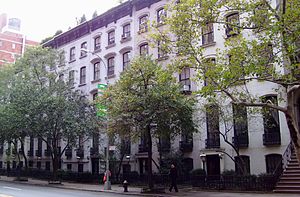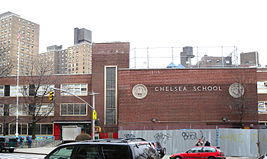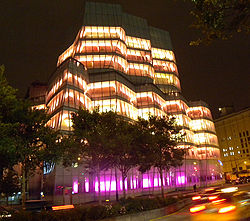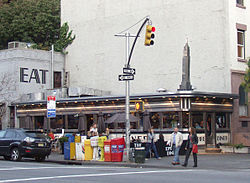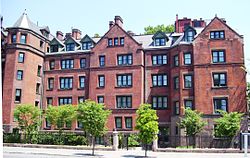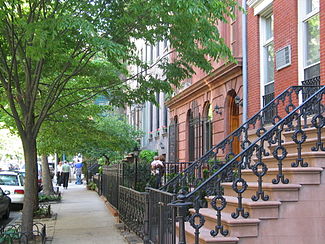- Chelsea, Manhattan
-
"Chelsea, New York" redirects here. For the upstate hamlet, see Chelsea, Dutchess County, New York.Chelsea Historic District
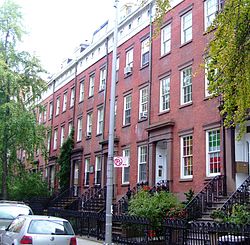 The Cushman Row, 406-418 W. 20th St. (1840)
The Cushman Row, 406-418 W. 20th St. (1840)Location: Roughly:
W 19th–W 23rd Sts
Eighth–Tenth Aves[2]Coordinates: 40°44′43″N 74°0′8″W / 40.74528°N 74.00222°WCoordinates: 40°44′43″N 74°0′8″W / 40.74528°N 74.00222°W Built: 1830 Architect: Multiple Architectural style: Greek Revival, Italianate, Georgian NRHP Reference#: 77000954 (original)
82001190 (increase)[1]Significant dates Added to NRHP: December 6, 1977 (original)
December 16, 1982 (increase)Designated NYCL: 1970 (original)
1981 (extension)Chelsea is a neighborhood on the West Side of the borough of Manhattan in New York City. The district's boundaries are roughly 14th Street to the south, 30th Street to the north, the western boundary of the Ladies' Mile Historic District – which lies between the Avenue of the Americas (Sixth Avenue) and Seventh Avenue – to the east, and the Hudson River and West Street to the west. To the north of Chelsea is the neighborhood of Hell's Kitchen, also known as "Clinton," to the northeast is the Garment District, to the east are NoMad and the Flatiron District, to the southwest is the Meatpacking District and to the southeast is the West Village.[3]
Chelsea is divided between Manhattan Community Board 4 and Manhattan Community Board 5. It contains the Chelsea Historic District and its extension, which were designated by the New York City Landmarks Preservation Commission in 1970 and 1981, respectively,[4] and added to the National Register of Historic Places in 1977, expanded in 1982 to include contiguous blocks containing particularly significant examples of period architecture.
The neighborhood is primarily residential, with a mix of tenements, apartment blocks, city housing projects, townhouses and renovated rowhouses, and its many retail businesses reflect the ethnic and social diversity of the population. The western part of Chelsea has become a center of the New York art world, with many art galleries located in both new buildings and rehabilitated warehouses.
Contents
History
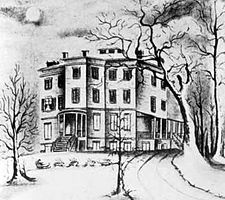 "Chelsea", drawn by a daughter of Clement Clarke Moore
"Chelsea", drawn by a daughter of Clement Clarke Moore
Chelsea takes its name from the estate and Georgian-style house of retired British Major Thomas Clarke, who obtained the property when he bought the farm of Jacob Somerindyck on August 16, 1750. The land was bounded by what would become 21st and 24th Streets, from the Hudson River to Eighth Avenue.[5] Clarke chose the name "Chelsea" after the manor of Chelsea, London, home to Sir Thomas More. Clarke passed the estate on to his daughter, Charity, who, with her husband Benjamin Moore, added land on the south of the estate, extending it to 19th Street.[5] The house was the birthplace of their son, Clement Clarke Moore, who in turn inherited the property. Moore is generally credited with writing "A Visit From St. Nicholas" and was the author of the first Greek and Hebrew lexicons printed in the United States.
In 1827, Moore gave the land of his apple orchard to the Episcopal Diocese of New York for the General Theological Seminary, which built its brownstone Gothic, tree-shaded campus south of the manor house. Despite his objections to the Commissioner's Plan of 1811, which ran the new Ninth Avenue through the middle of his estate, Moore began the development of Chelsea with the help of James N. Wells, dividing it up into lots along Ninth Avenue and selling them to well-heeled New Yorkers.[6] Covenants in the deeds of sale specified what could be built on the land – stables, manufacturing and commercial uses were forbidden – as well as architectural details of the buildings.[5]
The new neighborhood thrived for three decades, with many single family homes and rowhouses, in the process expanding past the original boundaries of Clarke's estate, but an industrial zone also began to develop along the Hudson.[5] In 1847 the Hudson River Railroad laid its freight tracks up a right-of-way between Tenth and Eleventh Avenues, separating Chelsea from the Hudson River waterfront. The industrialization of western Chelsea followed, and brought immigrant populations from many countries to work in the factories,[7] including a large number of Irish immigrants, who dominated work on the Hudson River piers that lined the nearby waterfront and the truck terminals integrated with the freight railroad spur.[8] As well as the piers, warehouses and factories, the industrial area west of Tenth Avenue also included lumberyards and breweries, and tenements built to house the workers. With the immigrant population came the political domination of the neighborhood by the Tammany Hall machine,[7] as well as festering ethnic tensions: around 67 people died in a riot between Irish Catholics and Irish Protestants on July 12, 1871, which took place around 24th Street and Eighth Avenue.[5][9] The social problems of the area's workers provoked John Lovejoy Elliot to form the Hudson Guild in 1897, one of the first settlement houses – private organizations designed to provide social services.
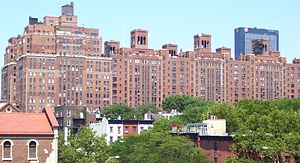 Part of the 23rd Street facade of the London Terrace apartment complex, as seen from the High Line at 20th Street. The complex takes up the full block between Ninth and Tenth Avenues and 23rd and 24th Streets.
Part of the 23rd Street facade of the London Terrace apartment complex, as seen from the High Line at 20th Street. The complex takes up the full block between Ninth and Tenth Avenues and 23rd and 24th Streets.
A theatre district formed in the area by 1869,[5] and soon West 23rd Street was the center of American theater, led by Pike's Opera House (1868, demolished 1960), on the northwest corner of Eighth Avenue. Chelsea was an early center for the motion picture industry before World War I. Some of Mary Pickford's first pictures were made on the top floors of an armory building at 221 West 26th Street, while other studios were located on 23rd and 21st Streets.[7]
London Terrace was one of the world's largest apartment blocks when it opened in 1930, with a swimming pool, solarium, gymnasium, and doormen dressed as London bobbies. Other major housing complexes in the Chelsea area are Penn South, a 1962 Mitchell-Lama cooperative housing development sponsored by the International Ladies Garment Workers' Union, and the New York City Housing Authority-built and -operated Fulton Houses and Chelsea-Elliot Houses.
 The Art Deco Verizon building entrance on 17th Street
The Art Deco Verizon building entrance on 17th Street
The massive 19-story Art Deco Verizon building, which spans the block between 17th and 18th Streets just off of Seventh Avenue, was built in the early 1930s. It typifies the real estate activity of the district in that in 2011 it is under consideration for conversion to condos.
In the early 1940s, tons of uranium for the Manhattan Project were stored in the Baker & Williams Warehouse at 513-519 West 20th St. The uranium was removed and decontaminated only in the late 1980s or early 1990s.[10]
Today
The retail stores of Chelsea reflect the ethnic and social diversity of the area's population. Ethnic restaurants, delis and clothing boutiques are plentiful. Tekserve, a vast Apple computer repair shop, serves nearby Silicon Alley and the area's large creative community. The Chelsea Lofts district – the former fur and flower district – is located roughly between Sixth and Seventh Avenues from 23rd to 30th streets. Chelsea has a large gay population, stereotyped as gym-toned "Chelsea boys."
Most recently, Chelsea has become an alternative shopping destination with Barneys CO-OP - which replaced the much larger original Barneys flagship store - Comme des Garçons, and Balenciaga boutiques, as well as being near Alexander McQueen, Stella McCartney, Christian Louboutin. Chelsea Market, on the ground floor of the former Nabisco Building, is a destination for food lovers.
As New York's visual arts community moved from SoHo to West Chelsea in the 1990s, the area bounded by 10th and 11th Avenues and 18th St. and 28th St. has become one of the global centers of contemporary art. The West Chelsea Arts District is home to over 370 art galleries and innumerable artist studios.
Education
There are numerous public schools in Chelsea, including Public School 11 – also known as the William T. Harris School, Public School 33 – the Chelsea School, Intermediate School 70 – also known as the O'Henry School, Liberty High School For Newcomers, Lab School, and the Humanities Educational Complex, which contains a number of small schools and academies. Private secondary schools in the neighborhood include the Catholic Xavier High School.
Chelsea is also home to the Fashion Institute of Technology, a specialized SUNY unit that serves as a training ground for the city's fashion and design industries. The School of Visual Arts, an independent college and the public High School of Fashion Industries also have a presence in the design fields.
The neighborhood is also home to the General Theological Seminary of the Episcopal Church, the oldest seminary in the Anglican Communion. The Center for Jewish History, a consortium of several national research organizations, is a unified library, exhibition, conference, lecture, and performance venue, located on 17th Street between Fifth and Sixth Avenues.
Culture
People of many different cultures live in Chelsea. Above 23rd Street, by the Hudson River, the neighborhood is post-industrial, featuring the newly-hip High Line that follows the river all through Chelsea.[11][12] Eighth Avenue is a center for LGBT-oriented shopping and dining, and from 20th to 22nd Streets between Ninth and Tenth Avenues, mid-nineteenth-century brick and brownstone townhouses are still occupied, a few even restored to single family use.[13]
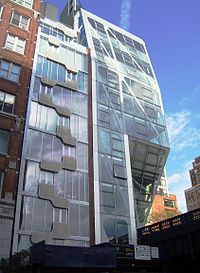 The conversion of the High Line (seen on the right) to an elevated urban park has stimulated much real estate development in West Chelsea, such as these two luxury apartment buildings, "Highline 519" and "HL23" on 23rd Street
The conversion of the High Line (seen on the right) to an elevated urban park has stimulated much real estate development in West Chelsea, such as these two luxury apartment buildings, "Highline 519" and "HL23" on 23rd Street
Since the mid-1990s, Chelsea has become a center of the New York art world, as art galleries moved there from SoHo. From 16th Street to 27th Street, between 10th and 11th Avenues, there are more than 350 art galleries that are home to modern art from upcoming artists and respected artists as well.[14] Along with the art galleries, Chelsea is home to the Rubin Museum of Art - with a focus on Himalayan art, the Chelsea Art Museum, the Graffiti Research Lab and the Dance Theater Workshop - a performance space and support organization for dance companies. The community, in fact, is home to many highly regarded performance venues, among them the Joyce Theater - one of the city's premier modern dance emporiums and The Kitchen - a center for cutting-edge theatrical and visual arts.
With a change in zoning resolution in conjunction with the development of the High Line, Chelsea has experienced a new construction boom, with projects by notable architects such as Shigeru Ban, Neil Denari, Jean Nouvel, and Frank Gehry.
The Chelsea neighborhood is served by two weekly newspapers, the Chelsea-Clinton News and Chelsea Now.
Landmarks and places of interest
- Chelsea Piers – The Chelsea Piers were the city's primary luxury cruise terminal from 1910 until 1935. The RMS Titanic was headed to Pier 60 at the piers and the RMS Carpathia brought survivors to Pier 54 in the complex. The northern piers are now part of an entertainment and sports complex operated by Roland W. Betts. See also Hudson River Park.
- Chelsea Market – In an old, restored building, this marketplace hosts a variety of vendors, including bakeries, Italian grocery stores, a fish market, Manhattan Fruit Exchange, wine store, and many others.
- Chelsea Studios – Sound stage on 26th Street since 1914 where numerous movies and television shows have been produced.
- Church of the Holy Apostles [15]– Built in 1845-1848 to a design by Minard Lefever, with additions by Lefever in 1853-1854, and transepts by Charles Babcock added in 1858, this Italianate church was designated a New York City landmark in 1966 and is listed on the National Register of Historic Places. It is Lefever's only surviving building in Manhattan. The building, which featured an octagonal spire,[16] was burned in a serious fire in 1990, but stained glass windows by William Jay Bolton survived, and the church reopened in April 1994 after a major restoration.[4] The Episcopal parish is notable for hosting the city's largest program to feedthe poor,[17] and is the second and larger home of the LGBT-oriented synagogue, Congregation Beth Simchat Torah[18]
- Empire Diner – An art moderne diner designed by Fodero Dining Car Company and built in 1946, altered in 1979 by Carl Laanes. Located at 210 Tenth Avenue at 22nd Street, it has been seen in several movies and mentioned in Billy Joel's song "Great Wall of China". The diner closed its doors for good on May 15, 2010.[19]
- The General Theological Seminary of the Episcopal Church – Its college-like close is sometimes called "Chelsea Square", a city block of tree-shaded lawns between Ninth and Tenth Avenues and West 20th and 21st Streets. The campus is ringed by more than a dozen brick and brownstone buildings in Gothic Revival style. The oldest building on the campus dates from 1836. Most of the rest were designed as a group by architect Charles Coolidge Haight, under the guidance of the Dean, Augustus Hoffman.
- High Line – The High Line is an elevated rail line, the successor to the street-level freight line original built through Chelsea in 1847, which was the cause of numerous fatal accidents. It was elevated in the early 1930s by the New York Central Railroad, but fell out of use. Originally slated to be torn down, it has now been converted into an elevated urban park.
- Hotel Chelsea – Built in 1883-1885 and designed by Hubert, Pirsson & Co., it was New York's first cooperative apartment complex[4] and was the tallest building in the city until 1902. After the theater district migrated uptown and the neighborhood became commercialized, the residential building folded and in 1905 it was turned into a hotel.[20] The hotel attracted attention as the place where Dylan Thomas had been staying when he died in 1953 at St. Vincent's Hospital in Greenwich Village, and for the 1978 slaying of Nancy Spungen for which Sid Vicious was accused. The Hotel has been the home of numerous celebrities, including Brendan Behan, Thomas Wolfe, Mark Twain, Tennessee Williams and Virgil Thomson,[4] and the subject of books, films (Chelsea Girls, 1966) and music.
- Hudson River Park – The entire Hudson River waterfront from 59th Street to the Battery including most of associated piers is being transformed into a joint city/state park with non-traditional uses.
- London Terrace – The apartment complex on West 23rd was one of the world's largest apartment blocks when it opened in 1930, with a swimming pool, solarium, gymnasium, and doormen dressed as London bobbies. It was designed by Farrar and Watmough. It takes its name from the fashionable mid-19th century cottages which were once located there.[7]
- Penn South – A large limited-equity housing cooperative built by the United Housing Foundation and financed by the International Ladies' Garment Workers' Union covering six city blocks, between 8th and 9th Avenue and 23rd and 29th Street.
- Peter McManus Cafe – This bar and restaurant on Seventh Avenue at 19th Street is among the oldest family-owned and -operated bars in the city.
- Pike's Opera House – Built in 1868, and bought the next year by James Fisk and Jay Gould, who renamed it the Grand Opera House. Located on the corner of Eighth Avenue and 23rd Street, it survived until 1960 as an RKO movie theater.[7]
- Starett-Lehigh Building – This huge full-block freight terminal and warehouse on West 26th Street between Eleventh and Twelfth Avenues was built in 1930-1931 as a joint venture of the Starett real estate firm and the Lehigh Valley Railroad, and was engineered so that trains could pull directly into the ground floor of the building. Designed by Cory & Cory, the industrial behemoth was so architecturally notable that it was included in the Museum of Modern Art's 1932 "International Style" exhibition, one of only a few American buildings to be so honored. It was designated a New York City landmark in 1966.[4]
References
- Notes
- ^ "National Register Information System". National Register of Historic Places. National Park Service. 2008-04-15. http://nrhp.focus.nps.gov/natreg/docs/All_Data.html.
- ^ These are the boundaries of the historic district, not of the neighborhood. NYCLPC map of Chelsea Historic District
- ^ Neighborhoods in New York City do not have official status, and their boundaries are not specifically set by the city. (There are a number of Community Boards, whose boundaries are officially set, but these are fairly large and generally contain a number of neighborhoods, and the neighborhood map issued by the Department of City Planning only shows the largest ones.) Because of this, the definition of where neighborhoods begin and end is subject to a variety of forces, including the efforts of real estate concerns to promote certain areas, the use of neighborhood names in media news reports, and the everyday usage of people.
- ^ a b c d e New York City Landmarks Preservation Commission. Guide to New York City Landmarks (4th ed.) New York:Wiley, 2009. ISBN 978-0-470-28963-1, p.70-72
- ^ a b c d e f Regier, Hilda. "Chelsea" in Jackson, Kenneth T., ed (1995). The Encyclopedia of New York City. New Haven: Yale University Press. ISBN 0300055366., p.209
- ^ Burrows & Wallace, p.447
- ^ a b c d e Federal Writers' Project. New York City Guide. New York: Random House, 1939 ISBN 0-403-02921-X (Reprinted by Scholarly Press, 1976; often referred to as WPA Guide to New York City), pp. 151-155
- ^ The film On the Waterfront (1954) recreates this tough world, dramatized in Richard Rodgers' 1936 jazz ballet Slaughter on Tenth Avenue.
- ^ Burrows & Wallace, pp.1003-1008
- ^ Broad, William J. (October 30, 2007). "Why They Called It the Manhattan Project". The New York Times. http://www.nytimes.com/2007/10/30/science/30manh.html. Retrieved 2009-08-22.
- ^ http://www.nyc.gov/html/lpc/downloads/pdf/reports/WestChelsea_REPORT.pdf nyc.gov
- ^ http://www.nyc.gov/html/lpc/downloads/pdf/maps/WestChelseaHD.pdf nyc.gov
- ^ http://www.nyc.gov/html/lpc/downloads/pdf/maps/chelsea.pdf nyc.gov
- ^ "Stylish Traveler: Chelsea Girls", Travel + Leisure, September 2005. Accessed May 14, 2007. "With more than 200 galleries, Chelsea has plenty of variety. Here, eight of them that feature everything from paintings to sculpture, videos to installations."; "City Planning Begins Public Review for West Chelsea Rezoning to Permit Housing Developm,ent and Create Mechanism for Preserving and Creating Access to the High Line", Department of City Planning press release, December 20, 2004. "Some 200 galleries have opened their doors in recent years, making West Chelsea a destination for art lovers from around the City and the world."
- ^ http://www.holyapostlesnyc.org/
- ^ http://www.nyc-architecture.com/CHE/CHE022-ChurchoftheHolyApostles.htm
- ^ Quindlen, Anna (November 17, 2007). "Blessed Is the Full Plate". Newsweek. http://www.newsweek.com/id/70982. Retrieved 2011-11-03.
- ^ http://www.lgbtran.org/Exhibits/CBST/index.aspx
- ^ "Empire Diner"
- ^ Leffel, C. and Lehman, J. The Best Things to Do in New York. New York: Universal Publishing 2006.
- Bibliography
- Burrows, Edwin G. & Wallace, Mike (1999). Gotham: A History of New York City to 1898. New York: Oxford University Press. ISBN 0195116348.
External links
- Chelsea Click Your Block ChelseaClickYourBlock.com is a blog site for individual residential Chelsea blocks.
- DestinationChelsea.org Local guide to Chelsea's cultural events and neighborhood establishments
- Interactive Map of Chelsea Art Galleries: chelseagallerymap.com
- Chelsea Neighborhood Profile - About.com
- CB4 The Chelsea Community Board
- GayCities New York Guide to Gay Bars & Clubs in Chelsea
- Chelsea Art Galleries
- Fine Art Gallery on West 25th
- Chelsea galleries on ArtCat
- Chelsea Neighborhood Guide
- Fischbach Gallery - A New York Contemporary Realism Art Gallery in Chelsea
- ClubFly Chelsea: Gay bars, clubs and a google map
Categories:- Historic districts in the United States
- Neighborhoods in Manhattan
- Gay villages in New York
- Art gallery places
- National Register of Historic Places in Manhattan
- LGBT culture in New York City
Wikimedia Foundation. 2010.

